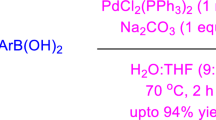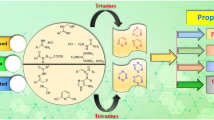Abstract
Organoactinide complexes containing terminal metal-ligand multiple bonds have received widespread attention over the past three decades. In the last few years, significant progress has been made in the synthesis and characterization of the imido, oxo, sulfido, and carbene-containing complexes of thorium. Such thorium complexes are of interest because of their unique structural properties, their potential application in novel group transfer reactions and catalysis, as well as their ability to engage the 5f orbitals in metal-ligand bonding. This short review summarizes the synthesis and reactivity of these thorium complexes.
Similar content being viewed by others
References
Zi GF, Zhang ZB, Xiang L, Wang QW. Progress in multiple-bonded organoactinides. Chin J Org Chem, 2006, 26: 1606–1611
Fox AR, Bart SC, Meyer K, Cummins CC. Towards uranium catalysts. Nature, 2008, 455: 341–349
Hayton TW. Metal-ligand multiple bonding in uranium: structure and reactivity. Dalton Trans, 2010, 39: 1145–1158
Qiu J, Burns PC. Clusters of actinides with oxide, peroxide, or hydroxide bridges. Chem Rev, 2013, 113: 1097–1120
Jones MB, Gaunt AJ. Recent developments in synthesis and structural chemistry of nonaqueous actinide complexes. Chem Rev, 2013, 113: 1137–1198
Nyman M, Burns PC. A comprehensive comparison of transition-metal and actinyl polyoxometalates. Chem Soc Rev, 2012, 41: 7354–7367
Natrajan LS. Developments in the photophysics and photochemistry of actinide ions and their coordination compounds. Coord Chem Rev, 2012, 256: 1583–1603
Andrews MB, Cahill CL. Uranyl bearing hybrid materials: synthesis, speciation, and solid-state structures. Chem Rev, 2013, 113: 1121–1136
Baker RJ. New reactivity of the uranyl(VI) ion. Chem Eur J, 2012, 18: 16258–16271
Ren W, Zhao N, Chen L, Zi G. Progress in terminal-imido organoactinide complexes. Chin J Org Chem, 2013, 33: 771–779
Hayton TW. Recent developments in actinide-ligand multiple bonding. Chem Commun, 2013, 49: 2956–2973
Ephritikhine M. Recent advances in organoactinide chemistry as exemplified by cyclopentadienyl compounds. Organometallics, 2013, 32: 2464–2488
Haskel A, Straub T, Eisen MS. Organoactinide-catalyzed intermolecular hydroamination of terminal alkynes. Organometallics, 1996, 15: 3773–3775
Straub T, Haskel A, Neyroud TG, Kapon M, Botoshansky M, Eisen MS. Intermolecular hydroamination of terminal alkynes catalyzed by organoactinide complexes. Scope and mechanistic studies. Organometallics, 2001, 20: 5017–5035
Korobkov I, Gambarotta S, Yap GPA. The first thorium arene complex: a divalent synthon. Angew Chem Int Ed, 2003, 42: 814–818
Schelter EJ, Morris DE, Scott BL, Kiplinger JL. Actinide-mediated coupling of 4-fluorobenzonitrile: synthesis of an eight-membered thorium(IV) tetraazametallacycle. Chem Commun, 2007: 1029–1031
Ren W, Zi G, Fang DC, Walter MD. A base-free thorium-terminal-imido metallocene: synthesis, structure and reactivity. Chem Eur J, 2011, 17: 12669–12682
Ren W, Zi G, Fang DC, Walter MD. Thorium oxo and sulfido metallocenes: synthesis, structure, reactivity and computational studies. J Am Chem Soc, 2011, 133: 13183–13196
Ren W, Deng X, Zi G, Fang DC. The Th=C double bond: an experimental and computational study of thorium poly-carbene complexes. Dalton Trans, 2011, 40: 9662–9664
Ren W, Zi G, Walter MD. Synthesis, structure and reactivity of a thorium metallocene containing a 2,2′-bipyridyl ligand. Organometallics, 2012, 31: 672–679
Ren W, Song H, Zi G, Walter MD. A bipyridyl thorium metallocene: synthesis, structure and reactivity. Dalton Trans, 2012, 41: 5965–5973
Ren W, Lukens WW, Zi G, Maron L, Walter MD. Is the bipyridyl thorium metallocene a low-valent thorium complex? A combined experimental and computational study. Chem Sci, 2013, 4: 1168–1174
Wang X, Andrews L, Thanthiriwatte KS, Dixon DA. Infrared spectra of H2ThS and H2US in noble gas matrixes: enhanced H-An-S covalent bonding. Inorg Chem, 2013, 52: 10275–10285
Mills DP, Cooper OJ, Tuna F, McInnes EJL, Davies ES, McMaster J, Moro F, Lewis W, Blake AJ, Liddle ST. Synthesis of a uranium(VI)-carbene: reductive formation of uranyl(V)-methanides, oxidative preparation of a [R2C=U=O]2+ analogue of the [O=U=O]2+ uranyl ion (R = Ph2PNSiMe3), and comparison of the nature of UIV=C, UV=C, and UVI=C double bonds. J Am Chem Soc, 2012, 134: 10047–10054
Thomson RK, Cantat T, Scott BL, Morris DE, Batista ER, Kiplinger JL. Uranium azide photolysis results in C-H bond activation and provides evidence for a terminal uranium nitride. Nat Chem, 2010, 2: 723–729
Minasian SG, Keith JM, Batista ER, Boland KS, Clark DL, Conradson SD, Kozimor SA, Martin RL, Schwarz DE, Shuh DK, Wagner GL, Wilkerson MP, Wolfsberg LE, Yang P. Determining relative f and d orbital contributions to M-Cl covalency in MCl6 2− (M = Ti, Zr, Hf, U) and UOCl5 − using Cl K-edge X-ray absorption spectroscopy and time-dependent density functional theory. J Am Chem Soc, 2012, 134: 5586–5597
Kaltsoyannis N. Does covalency increase or decrease across the actinide series? Implications for minor actinide partitioning. Inorg Chem, 2013, 52: 3407–3413
Bagnall KW. The Actinide Elements. Amsterdam: Elsevier, 1972.
Choppin GR. Covalency in f-element bonds. J Alloys Compd, 2002, 344: 55–59
Parkin, G. Terminal chalcogenido complexes of the transition metals. Prog Inorg Chem, 1998, 47: 1–165
Warncke R. Gmelin Handbuch der Anorganischen Chemie. Ergänzungsband Teil C1: Thorium. Berlin: Springer-Verlag, 1978.
Zi GF, Jia L, Werkema EL, Walter MD, Gottfriedsen JP, Andersen RA. Preparation and reactions of base-free bis(1,2,4-tri-tert-butylcy-clopentadienyl)uranium oxide, Cp′2UO. Organometallics, 2005, 24: 4251–4264
Kraft SJ, Walensky J, Franwick PE, Hall MB, Bart SC. Crystallographic evidence of a base-free uranium(IV) terminal oxo species. Inorg Chem, 2010, 49: 7620–7622
Zi G, Blosch LL, Jia L, Andersen RA. Preparation and reactions of base-free bis(1,3,4-tri-tert-butylcyclopentadienyl)uranium methylimide, Cp′2U=NMe, and related compounds. Organometallics, 2005, 24: 4602–4612
Nugent LJ, Baybarz RD, Burnett JL, Ryan JL. Electron-transfer and f-d absorption bands of some lanthanide and actinide complexes and the standard (II–III) oxidation potential for each member of the lanthanide and actinide series. J Phys Chem, 1973, 77: 1528–1539
Shannon RD. Revised effective ionic radii and systematic studies of interatomic distances in halides and chalcogenides. Acta Crystallogr Sect A, 1976, 32: 751–767
Howard WA, Trnka TM, Waters M, Parkin G. Terminal chalcogenido complexes of zirconium: syntheses and reactivity of Cp2*Zr(E)(NC5H5) (E = O, S, Se, Te). J Organomet Chem, 1997, 528: 95–121
Polse JL, Andersen RA, Bergman RG. Cycloaddition and cycloreversion reactions of a monomeric Ti(IV) oxo complex with terminal and internal alkynes. A reversible oxametallacyclobutene/hydroxoacetylide interconversion. J Am Chem Soc, 1995, 117: 5393–5394
Carney MJ, Walsh PJ, Bergman RG. Room temperature generation of reactive intermediates Cp*2Zr=O and Cp*2Zr=S: trapping reactions with unsaturated organic molecules and dative ligands. J Am Chem Soc, 1990, 112: 6426–6428
Barros N, Maynau D, Maron L, Eisenstein O, Zi G, Andersen RA. Single but stronger UO, double but weaker UNMe bonds: the tale told by Cp2UO and Cp2UNR. Organometallics, 2007, 26: 5059–5065
Yahia A, Maron L. Is thorium a d transition metal or an actinide? An answer from a DFT study of the reaction between pyridine N-oxide and Cp2M(CH3)2 with M = Zr, Th, and U. Organoemtallics, 2009, 28: 672–679
Hutchings GJ, Heneghan CS, Hudson ID, Taylor SH. Uranium-oxide-based catalysts for the destruction of volatile chloro-organic compounds. Nature, 1996, 384: 341–343
Sweeney ZK, Polse JL, Andersen RA, Bergman RG. Cycloaddition and nucleophilic substitution reactions of the monomeric titanocene sulfido complex (η 5-C5Me5)2(C5H5N)Ti=S. J Am Chem Soc, 1998, 120: 7825–7834
Mohammad A, Cladis DP, Forrest WP, Franwick PE, Bart SC. Reductive heterocoupling mediated by Cp*2U(2,2′-bpy). Chem Commun, 2012, 48: 1671–1673
Ma G, Ferguson MJ, McDonald R, Cavell RG. Actinide metals with multiple bonds to carbon: synthesis, characterization, and reactivity of U(IV) and Th(IV) bis(iminophosphorano)methandiide pincer carbene complexes. Inorg Chem, 2011, 50: 6500–6508
King DM, Tuna F, McInnes EJL, McMaster J, Lewis W, Blake AJ, Liddle ST. Synthesis and structure of a terminal uranium nitride complex. Science, 2012, 337: 717–720
King DM, Tuna F, McInnes EJL, McMaster J, Lewis W, Blake AJ, Liddle ST. Isolation and characterization of a uranium(VI)-nitride triple bond. Nat Chem, 2013, 5: 482–488
Hayton TW. Uranium chemistry an actinide milestone. Nat Chem, 2013, 5: 451–452
Author information
Authors and Affiliations
Corresponding author
Additional information
Dedicated to Professor Qian Changtao on the occasion of his 80th birthday.
ZI GuoFu studied chemistry at Beijing Normal University from 1992 to 1998, where he received his BSc and MSc degrees in 1996 and 1998, respectively. After finished his PhD in 2002 under guidance of Professor Zuowei Xie at the Chinese University of Hong Kong, he joined the group of Professor Richard A. Andersen at the University of California at Berkeley as a postdoctoral fellow. In 2005 he began his independent research career as a principal investigator at Beijing Normal University. His research interests include organometallic chemistry and organic synthesis. He has co-authored about 80 publications in peer-reviewed journals.
Rights and permissions
About this article
Cite this article
Zi, G. Organothorium complexes containing terminal metal-ligand multiple bonds. Sci. China Chem. 57, 1064–1072 (2014). https://doi.org/10.1007/s11426-014-5094-y
Received:
Accepted:
Published:
Issue Date:
DOI: https://doi.org/10.1007/s11426-014-5094-y




